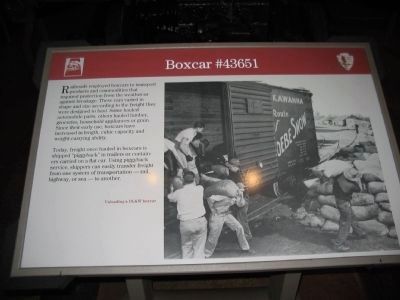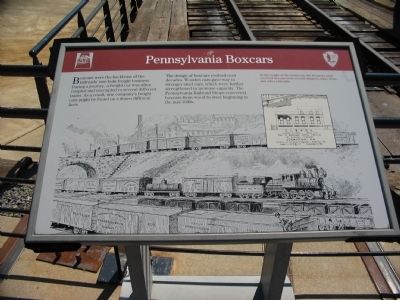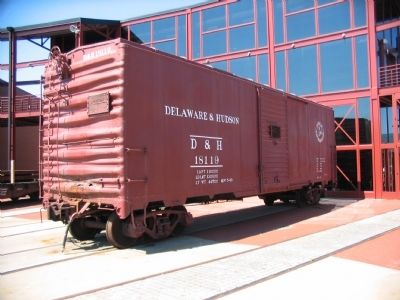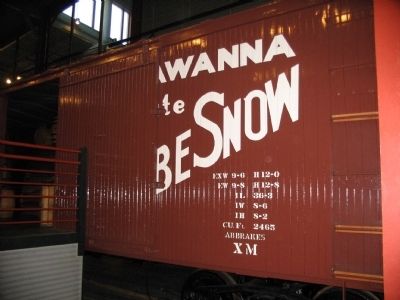Scranton in Lackawanna County, Pennsylvania — The American Northeast (Mid-Atlantic)
Pennsylvania Boxcars
The design of boxcars evolved over decades. Wooden cars gave way to stronger steel cars, which were further strengthened to increase capacity. The Pennsylvania Railroad Shops converted boxcars from wood to steel beginning in the mid-1940s.
At the height of the steam era, the Scranton yard received boxcars from several shippers, many cities, and other railroads.
Erected by Steamtown Nataionl Historic Site - National Park Service.
Topics. This historical marker is listed in this topic list: Railroads & Streetcars.
Location. 41° 24.43′ N, 75° 40.28′ W. Marker is in Scranton, Pennsylvania, in Lackawanna County. Marker can be reached from Mechanic Street, on the right when traveling east. Located in the Roundhouse in Steamtown National Historic Site. Touch for map. Marker is in this post office area: Scranton PA 18503, United States of America. Touch for directions.
Other nearby markers. At least 8 other markers are within walking distance of this marker. 1902/1937 Roundhouse (within shouting distance of this marker); 1902/1937 Inspection Pit (within shouting distance of this marker); 1865 Inspection Pit (within shouting distance of this marker); Turntable (within shouting distance of this marker); New Haven Trap Rock Company #43 (within shouting distance of this marker); E.J. Lavino & Company #3 (within shouting distance of this marker); 1902 Roundhouse Section (within shouting distance of this marker); CNJ #5 Steam Derrick (within shouting distance of this marker). Touch for a list and map of all markers in Scranton.
Also see . . . Boxcar #43651. (PDF) Additional details from the park service site. (Submitted on June 9, 2009, by Craig Swain of Leesburg, Virginia.)

Photographed By Craig Swain, July 25, 2008
4. Boxcar #43651
From one of the park's inside displays:
Railroads employed boxcars to transport products and commodities that required protection from the weather or against breakage. These cars varied in shape and size according to the freight they were designed to haul. Some hauled automobile parts, others hauled lumber, groceries, household appliances or grain. Since their early use, boxcars have increased in length, cubic capacity and weight-carrying ability.
Today, freight once hauled in boxcars is shipped "piggyback" in trailers or containers carried on a flat car. Using piggyback service, shippers can easily transfer freight from one system of transportation - rail, highway, or sea - to another.
Railroads employed boxcars to transport products and commodities that required protection from the weather or against breakage. These cars varied in shape and size according to the freight they were designed to haul. Some hauled automobile parts, others hauled lumber, groceries, household appliances or grain. Since their early use, boxcars have increased in length, cubic capacity and weight-carrying ability.
Today, freight once hauled in boxcars is shipped "piggyback" in trailers or containers carried on a flat car. Using piggyback service, shippers can easily transfer freight from one system of transportation - rail, highway, or sea - to another.
Credits. This page was last revised on June 16, 2016. It was originally submitted on June 9, 2009, by Craig Swain of Leesburg, Virginia. This page has been viewed 783 times since then and 30 times this year. Photos: 1, 2, 3, 4. submitted on June 9, 2009, by Craig Swain of Leesburg, Virginia.


